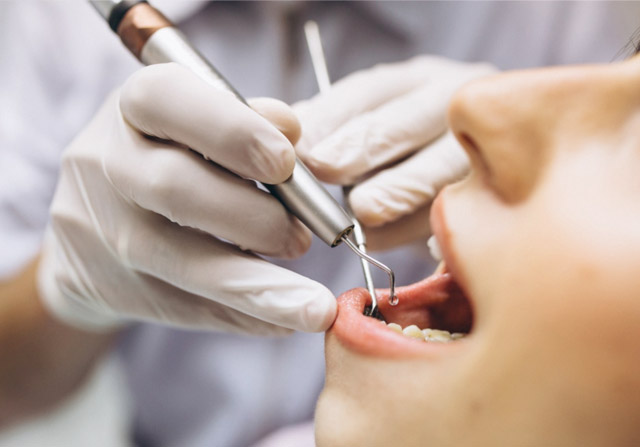 Open wechat
Open wechatA large part of the outpatient work of oral surgery is to extract teeth for patients. Tooth extraction seems simple, but there are risks. For patients, sudden situations may also occur. During or after tooth extraction, local anesthesia allergy, hematoma, bleeding, postoperative pain, secondary bleeding, postoperative infection, blood pressure fluctuation, and syncope are also common.
Syncope causes vary
Syncope is not a single disease, but a syndrome caused by multiple causes.
1. Simple syncope, also known as neuroreflex syncope. These include vasovagal syncope, orthostatic hypotension syncope, carotid sinus syncope, urination syncope, swallowing cough syncope, etc. The common syncope associated with tooth extraction is vasovagal syncope and orthostatic hypotension syncope.
(1) Vasovagal syncope, also known as neuroreflex syncope, is more common in young people, especially in women with weak physique and unstable mood. Due to external stimulation (tension, pain caused by injection, etc.), peripheral blood vessel dilation is caused by vagal reflex, and transient cerebral ischemia and syncope occur due to reduced return blood flow.
(2) Orthostatic hypotensive syncope is also called postural syncope. Old people are common. After the tooth extraction operation, the patient changed from the supine position to the standing position, the body position suddenly changed, and the nervous reflex of the body to adjust the blood pressure was out of balance. Due to the accumulation of blood in both lower limbs, the amount of blood returning to the heart was reduced, and the blood pressure suddenly decreased, resulting in the brain blood insufficiency and syncope.
2. Cardiogenic syncope. It is mainly due to syncope caused by various cardiovascular diseases.
For patients with cardiovascular diseases who have been clearly diagnosed, before removing the teeth, they are required to truthfully explain their conditions to the doctor, such as hypertension, coronary heart disease, valvular heart disease, cardiomyopathy, arrhythmia, the time of coronary intervention treatment and oral anticoagulants. For such patients, it is necessary to go to the oral clinic with ECG monitoring conditions for tooth extraction under the condition that blood pressure, rhythm, heart rate and blood sugar are well controlled and cardiac function is stable to prevent cardiogenic syncope.
3. Brain syncope. For example, severe cerebral artery occlusion, hypertensive encephalopathy, basilar artery type migraine and so on are rarely encountered in oral clinics due to their severe illness.
4. Others. Such as crying syncope, hyperventilation syndrome, hypoglycemic syncope, etc. Hypoglycemic syncope is also common in oral clinics. For patients with diabetes, those who eat irregularly and those who do not eat breakfast for a long time, attention should be paid to prevent the occurrence of hypoglycemic syncope.
Familiar with common symptoms of syncope
During or after tooth extraction, if the patient feels dizziness, nausea, cold sweat, pale face, and blackness in front of his eyes, lasting for several seconds to several seconds, then he will lose consciousness and faint. Or stand and fall to the ground after tooth extraction. At this time, the patient is in the syncope stage and may lose consciousness, accompanied by decreased blood pressure, weak pulse or tachycardia turning into bradycardia, and individuals with urinary incontinence. If the patient is treated in time, he will soon wake up. However, the symptoms of dizziness, headache, nausea and weakness can still be left, and the symptoms can completely disappear after rest.
Master the basic principles of treatment
Rescue on the spot, do not move the patient at will, this is the basic principle of on-site rescue. If the patient faints on the treatment chair, the doctor and nurse should immediately put the treatment chair flat, take the head down, untie the patient's collar, keep the surrounding air flowing, and stop all tooth extraction operations. Quickly press the patient's first aid acupoints such as Renzhong, Neiguan and Hegu with the index finger, and put a cotton ball containing 75% alcohol on the patient's nostril to stimulate breathing. If the cause of hypoglycemia is considered, glucose water can be taken orally or 50% glucose injection can be injected intravenously. If the patient is found to be hyperventilating due to local anesthetic injection, ask the patient to hold his breath and slow down his breathing rate.
Through the above simple first aid measures, the patients who suffered from syncope during tooth extraction can quickly return to normal. If the patient is accompanied by limb convulsions and cannot wake up, the patient should consider the epileptic seizures, and immediately inject 10% calcium gluconate intravenously, or inject diazepam injection intramuscularly or intravenously.
Finally, it should be reminded that syncope must be distinguished from seizures, dizziness, shock and coma.


